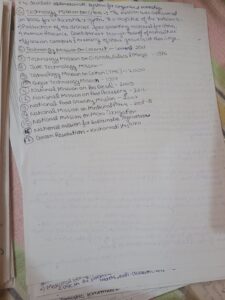Public distribution system (PDS) is a government-sponsored mechanism entrusted with the work of distributing basic food and non-food commodities to the needy sections of the society at subsidised rates. The system is operated jointly by the Central and the state governments. It has following objectiRead more
Public distribution system (PDS) is a government-sponsored mechanism entrusted with the work of distributing basic food and non-food commodities to the needy sections of the society at subsidised rates. The system is operated jointly by the Central and the state governments.
It has following objectives
- To provide essential consumer goods at cheap and subsidised prices.
- To insulate consumers from the impact of rising prices of these commodities.
- To maintain the minimum nutritional status of our population.
- To put an Indirect check on the open market prices of various items.
It is supplemental in nature and is not intended to make available the entire requirement of any of the commodities distributed under it to a household or section of the society. Yet, it acts as a safety net for a large section of the population.
Limitations of PDS In India
- Uneven coverage: Initially the PDS in India was perceived to have an urban bias. Even as PDS expanded across rural areas, its effectiveness in terms of timely and adequate availability especially in remote, inaccessible and backward areas remains meagre.
- Limited benefits for poor: Rural poor have not benefited much from PDS and their dependence on the open market has been much higher than on PDS.
- Economic burden: After inclusion of National Food Security Act, 2013, the burden of food subsidy has become huge. Also, procurement prices have been rising continuously due to rich farmers’ lobby and issue prices are getting lower due to populist policies. All of this together makes the PDS unsustainable.
- Operational inefficiencies:
- The economic cost of FCI food grains operation has been rising due to distribution cost, carrying cost, etc. and also due to inefficiencies caused by highly centralised and bureaucratic mode of operations.
- Diversion of food grains to the open markets because of widespread prevalence of corruption and transportation losses form the major part of leakages.
- PDS also suffers from exclusion and inclusion errors in identification of beneficiaries.
- PDS results in price increase: Due to large procurement of food grains by the Government, net quantities available in the open market reduce. This leads to increase in price and adversely affects those who are excluded from the system.
Some recent steps taken by government
- Digital Record Keeping: Digitization of ration cards and End-to-End computerisation of Targeted PDS.
- Adhar Linkage: Linking the ration card with Aadhar and installation of ePOS (electronic point of sale) devices at the fair price shops to track the sale of food grain to actual cardholders on a real time basis.
- Integrated management of PDS (IM-PDS): The main objective of this scheme is to introduce a nation-wide portability of ration card holders to materialise the concept of One Nation One Ration Card.
To improve the PDS further, Wadhwa Committee (2006) and Shanta Kumar Committee (2015) have suggested universalisation of PDS, gradual introduction of cash transfers (DBT) and food coupons. A Universal Basic Income may also be introduced to do away with multiple subsidies existing in India.
See less


Technology has been playing a pivotal role in every sector of Indian Economy. Use of technology has been robust in recent decades and hence agriculture sector is also not left untouched by it. Recent developments in e-technology for Farmers. 1. NAM: National Agriculture Market is a portal launchedRead more
Technology has been playing a pivotal role in every sector of Indian Economy. Use of technology has been robust in recent decades and hence agriculture sector is also not left untouched by it.
Recent developments in e-technology for Farmers.
1. NAM: National Agriculture Market is a portal launched by the Indian Government to create a unified market across the country.
2. Direct Benefit Transfer (DBT) Scheme: Launched by the Central Government, it aims to provide direct cash transfer to the farmer’s bank account.
3. E- Choupal : An initiative by ITC to help farmers regarding the health of seeds and best agricultural practices.
4. The Digital Agriculture Mission: It aims to promote use of Blockchain Technology, Robotics in the agricultural field.
5. Agriculture Technology Management Agency: ATMA model has helped in contribution of diversification of agriculture in some states, is a promising example.
Although Indian agriculture is facing backwardness in the terms of its growth and share, but advancements like Robotics, drone technology and so on hold a promising future for this sector in terms of its growth.
See less